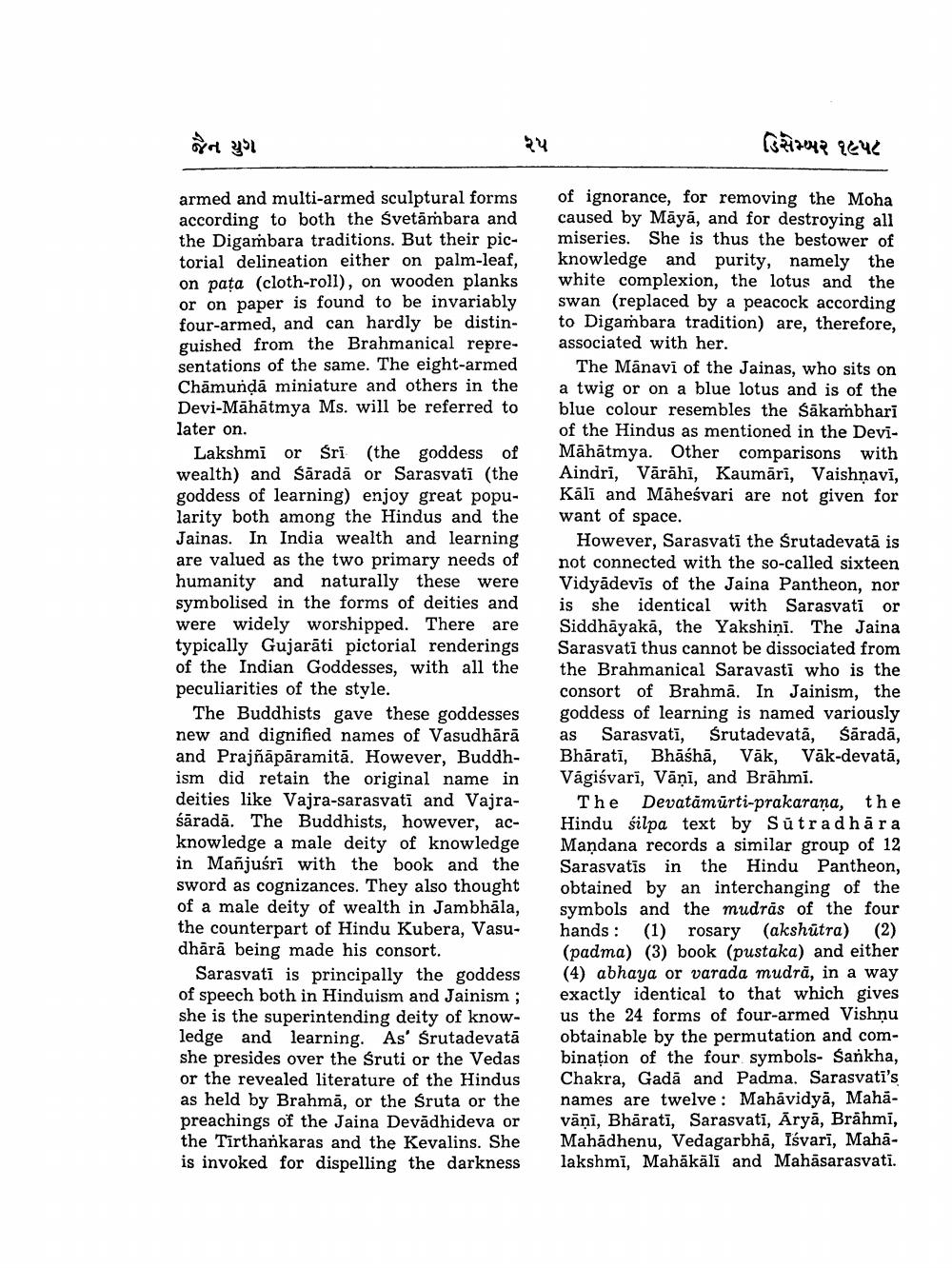________________
જેન યુગ
ડિસેમ્બર ૧૯૫૮
armed and multi-armed sculptural forms according to both the Svetämbara and the Digambara traditions. But their pictorial delineation either on palm-leaf, on pața (cloth-roll), on wooden planks or on paper is found to be invariably four-armed, and can hardly be distinguished from the Brahmanical repre. sentations of the same. The eight-armed Chāmundā miniature and others in the Devi-Māhātmya Ms. will be referred to later on.
Lakshmi or Sri (the goddess of wealth) and Saradā or Sarasvati (the goddess of learning) enjoy great popularity both among the Hindus and the Jainas. In India wealth and learning are valued as the two primary needs of humanity and naturally these were symbolised in the forms of deities and were widely worshipped. There are typically Gujarāti pictorial renderings of the Indian Goddesses, with all the peculiarities of the style.
The Buddhists gave these goddesses new and dignified names of Vasudhārā and Prajñāpāramitā. However, Buddhism did retain the original name in deities like Vajra-sarasvati and Vajraśāradā. The Buddhists, however, acknowledge a male deity of knowledge in Manjusri with the book and the sword as cognizances. They also thought of a male deity of wealth in Jambhāla, the counterpart of Hindu Kubera, Vasudhārā being made his consort.
Sarasvati is principally the goddess of speech both in Hinduism and Jainism ; she is the superintending deity of knowledge and learning. As' Srutadevatā she presides over the Šruti or the Vedas or the revealed literature of the Hindus as held by Brahmā, or the Sruta or the preachings of the Jaina Devādhideva or the Tirthankaras and the Kevalins. She is invoked for dispelling the darkness
of ignorance, for removing the Moha caused by Māyā, and for destroying all miseries. She is thus the bestower of knowledge and purity, namely the white complexion, the lotus and the swan (replaced by a peacock according to Digambara tradition) are, therefore, associated with her.
The Manavi of the Jainas, who sits on a twig or on a blue lotus and is of the blue colour resembles the Sākambhari of the Hindus as mentioned in the DeviMāhātmya. Other comparisons with Aindri, Vārāhi, Kaumāri, Vaishnavi, Kāli and Māheśvari are not given for want of space.
However, Sarasvati the Srutadevatā is not connected with the so-called sixteen Vidyādevis of the Jaina Pantheon, nor is she identical with Sarasvati or Siddhāyakā, the Yakshiņi. The Jaina Sarasvati thus cannot be dissociated from the Brahmanical Saravasti who is the consort of Brahmā. In Jainism, the goddess of learning is named variously as Sarasvati, śrutadevată, Săradā, Bhārati, Bhāśhā, Vāk, Vāk-devatā, Vāgisvarī, Vāņi, and Brāhmi.
The Devatāmūrti-prakaraņa, the Hindu silpa text by Sutradhāra Mandana records a similar group of 12 Sarasvatis in the Hindu Pantheon, obtained by an interchanging of the symbols and the mudrās of the four hands : (1) rosary (akshūtra) (2) (padma) (3) book (pustaka) and either (4) abhaya or varada mudrā, in a way exactly identical to that which gives us the 24 forms of four-armed Vishņu obtainable by the permutation and combination of the four symbols- Sankha, Chakra, Gadā and Padma. Sarasvati's names are twelve: Mahavidya, Mahaväņi, Bhāratī, Sarasvati, Āryā, Brāhmi, Mahādhenu, Vedagarbhā, Isvarī, Mahālakshmi, Mahäkāli and Mahäsarasvati.




